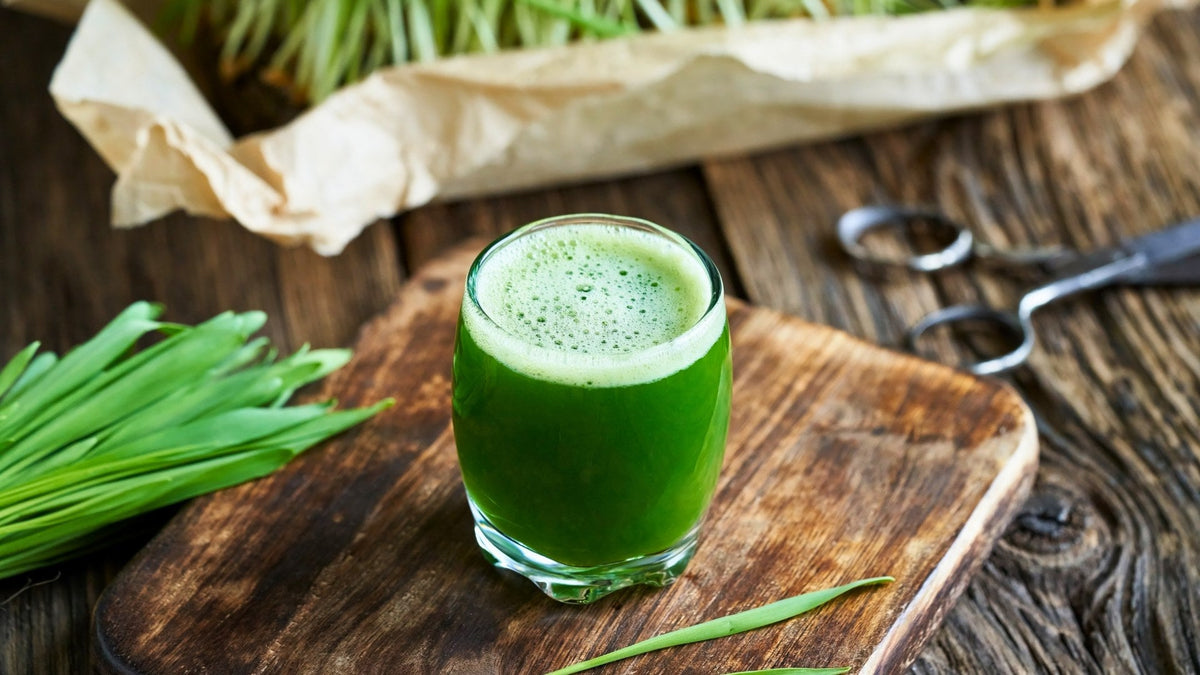
Does Barley Grass Detox Your Body?
|
|
Time to read 6 min
This store requires javascript to be enabled for some features to work correctly.
|
|
Time to read 6 min
Disclaimer: The information provided in this article is for informational purposes only and is not intended as a substitute for professional medical advice, diagnosis, or treatment. Always seek the advice of your physician or other qualified healthcare provider with any questions you may have regarding a medical condition or before making any changes to your diet or lifestyle, especially if you have existing health conditions.
Barley grass is derived from the young leaves of the barley plant (Hordeum vulgare). Barley grass is packed with essential vitamins, minerals, enzymes, and chlorophyll, making it a potent source of nutrients. It contains vitamins A, C, and K, along with minerals such as potassium, calcium, magnesium, and iron. The high concentration of chlorophyll gives barley grass its vibrant green colour and contributes to its potential health benefits, including detoxification.
Detoxification is the process of removing toxins from the body. Toxins can accumulate due to various factors, including pollution, processed foods, and stress. These toxins can lead to numerous health issues such as fatigue, digestive problems, and weakened immunity. Effective detoxification supports overall health by enhancing the body's natural ability to eliminate harmful substances. It is believed to improve energy levels, mental clarity, and overall well-being.
In this article, we will explore: does barley grass detox your body? We will summarise relevant scientific studies (with references and further reading) and also explain the mechanisms behind barley grass detoxification capabilities.
Ancient Cultivation: Barley is one of the oldest cultivated grains, with evidence of its use dating back over 10,000 years to the Fertile Crescent, making it a staple in ancient civilizations such as Mesopotamia, Egypt, and Greece.
Nutrient Powerhouse: Barley grass is packed with over 20 enzymes, including superoxide dismutase (SOD), which plays a critical role in detoxifying the body by neutralising free radicals.
Chlorophyll Champion: High in chlorophyll, barley grass helps detoxify the body by binding to and removing heavy metals and other toxins from the bloodstream.
Rich in Antioxidants: Barley grass contains high levels of antioxidants like flavonoids, phenolic acids, and proanthocyanidins, which protect cells from oxidative stress and reduce inflammation.
Cancer Prevention: Research indicates that the antioxidants and phytochemicals in barley grass can help prevent the growth of cancer cells by inducing apoptosis (programmed cell death) and inhibiting tumour formation.
Yes, barley grass can support detoxification in your body through several mechanisms, thanks to its rich nutritional profile and specific bio-active compounds.
Function: Chlorophyll, the green pigment in plants, has potent detoxifying properties. It helps in neutralising and eliminating toxins from the body by binding to harmful chemicals and heavy metals, facilitating their excretion. Barley grass generally contains about 0.3% to 1% chlorophyll by weight, with variations depending on the specific growing and processing conditions. This reduces the overall toxic burden on the liver and kidneys, the primary detox organs.
The study shows that germinated wheat and barley grasses can mitigate liver and brain damage in rats caused by drinking water contaminated with excessive heavy metals (Cu, Mn, Zn). This mitigation is achieved through the antioxidant properties of the grasses, their ability to enhance detoxification processes, reduce metal bioaccumulation, improve liver histology, and protect DNA from damage, ultimately improving liver function and reducing histopathological damage and metal concentrations in the body.
Publication Details: Authors - Hanan S.E. Eldamaty, Heba Elbasiouny, Amira M. Elmoslemany, Lamiaa M. Abd El-Maoula, Ola Ibrahim El-Desoky, Medhat Rehan, Diaa Abd El Moneim, Amina Zedan. Journal - Applied Sciences. Year - 2021.
The study underscores that barley grass powder is an effective functional food for detoxification and provides nutrition. Key functional ingredients include chlorophyll, superoxide dismutase (SOD), and flavonoids, which help eliminate toxins from cells. These components collectively enhance liver protection and have detoxifying effects, contributing to the elimination of harmful substances and supporting overall health.
Publication Details: Authors - Yawen Zeng, Xiaoying Pu, Jiazhen Yang, Juan Du, Xiaomeng Yang, Xia Li, Ling Li, Yan Zhou, Tao Yang. Journal - Oxidative Medicine and Cellular Longevity. Year - 2018.
The study examines the anti-obesity effects of barley grass juice on obese rats, highlighting its ability to significantly lower body weight, improve lipid profiles, and enhance liver function. It also reduced inflammation and promoted better lipid metabolism. The research suggests barley grass juice is a potent anti-obesity nutraceutical.
Publication Details: Jhansyrani Thatiparthi, Sujatha Dodoala, Bharathi Koganti, KVSRG Prasad; 2019; Journal of Ethnopharmacology.
This study examines the health benefits of barley grass powder, emphasising its nutritional content—such as GABA, flavonoids, saponarin, lutonarin, SOD, and essential vitamins and minerals. These nutrients contribute to various health advantages, including improved sleep, blood pressure regulation, enhanced immunity, liver protection, and anti-inflammatory and antioxidant properties. The research supports barley grass's potential as a functional food to prevent and manage chronic diseases and promote overall health.
Authors: Yawen Zeng, Xiaoying Pu, Jiazhen Yang, Juan Du, Xiaomeng Yang, Xia Li, Ling Li, Yan Zhou, Tao Yang. Date: April 4, 2018. Publication: Oxidative Medicine and Cellular Longevity.
This study highlights the protective effects of barley grass against dieldrin-induced toxicity (dieldrin is pesticide that was widely used in agriculture for controlling soil insects and termites which is now widely banned), which is primarily due to its high content of phenolic compounds and proanthocyanidins. These compounds have potent antioxidant properties, which help in scavenging free radicals and reducing oxidative stress. This antioxidant action plays a crucial role in preventing and mitigating liver and kidney damage caused by toxic substances like dieldrin.
Publication Details: Authors - Hallegue Dorsaf, Moujahed Sabrine, Ben Lamine Houda, Ben Rhouma Khémais, Sakly Mohsen, and Tebourbi Olfa. Journal of Food and Nutrition Research. Year - 2020.

